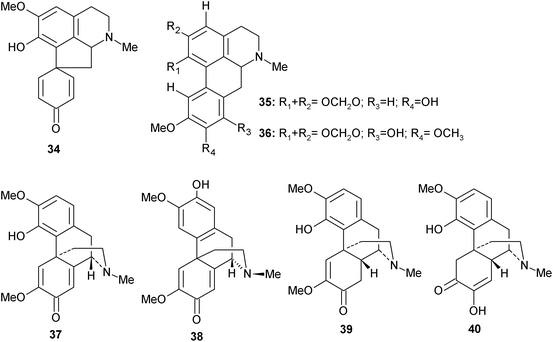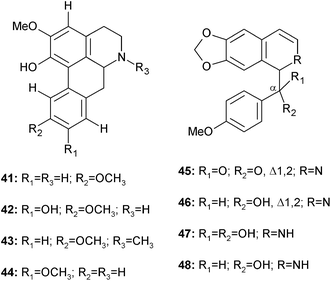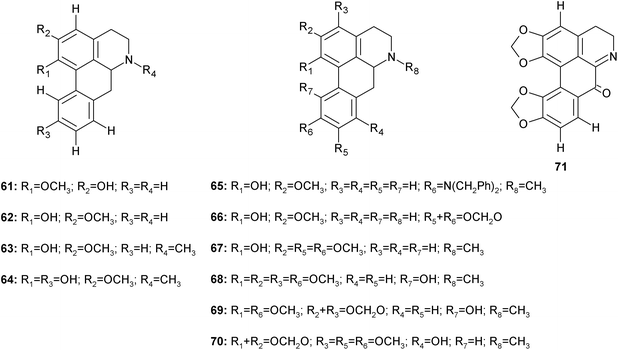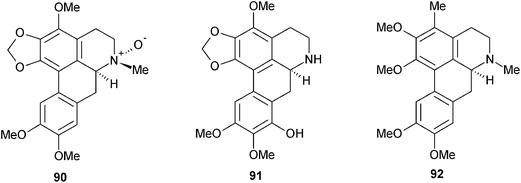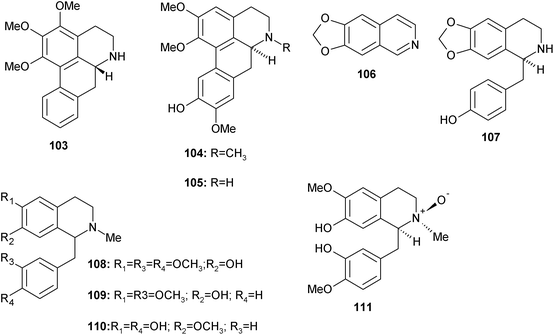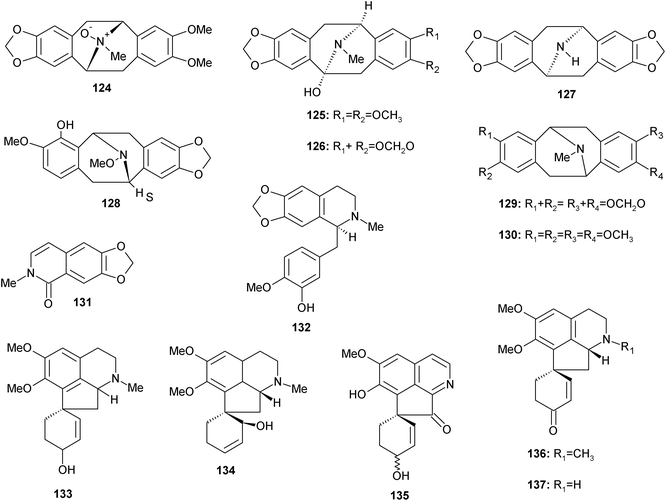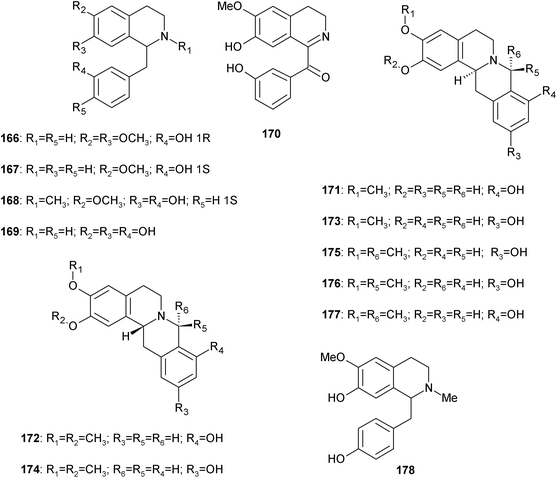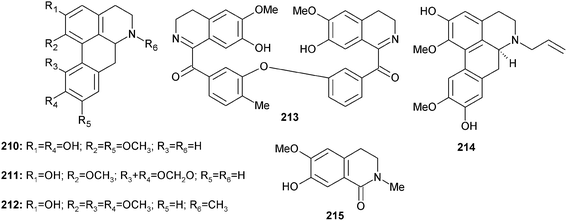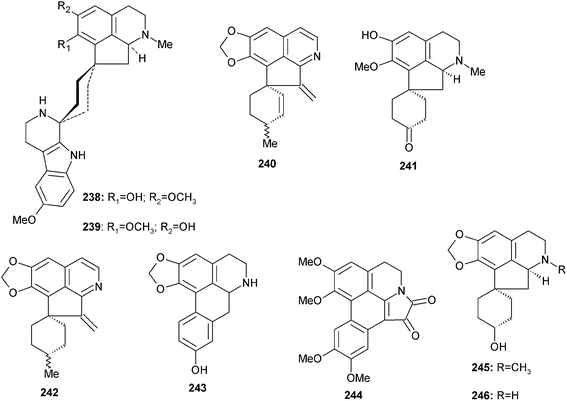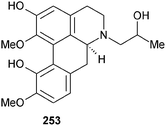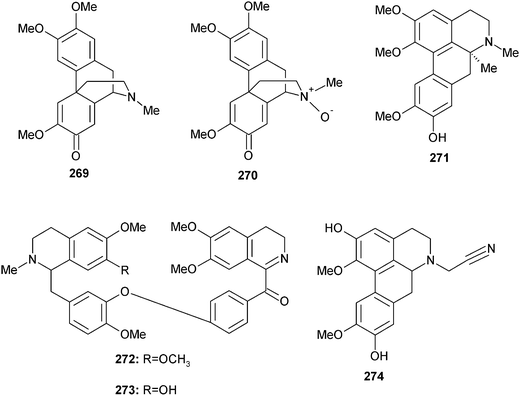Lauraceae alkaloids†
Dayana Lacerda Custódio
a and
Valdir Florêncio da Veiga Junior
*b
aInstituto Politécnico, Universidade do Estado do Rio de Janeiro, Rua Bonfim, 25. Vila Amélia, Cep: 28.625-570, Nova Friburgo/RJ-Brazil. E-mail: valdirveiga@ufam.edu.br
bDepartamento de Química, Instituto de Ciências exatas, Universidade Federal do Amazonas, Avenida Rodrigo Octávio, 6200, Coroado, CEP:69.077-000, Manaus/AM-Brazil
First published on 24th April 2014
Abstract
Lauraceae is one of the most representative botanical families, presenting 67 genera, with over 2500 species and more than 300 different alkaloids reported, mainly isoquinolines. Its diversity and relevance to chemosystematic relationships is presented and discussed.
1 Introduction
The Lauraceae botanical family has a tropical and subtropical distribution, concentrated in Asian and American rainforests, including about 67 genera with over 2500 species. It is found particularly in countries with biodiversity hotspots. Brazil, for example, has a great number of representative species, with approximately 25 genera and 400 Lauraceae species. Lauraceae is considered one of the most important families in floristic composition in some of its forest ecosystems.1,2Several Lauraceae species have been used in the manufacture of various products with great economic value in areas such as the food and wood industries, for example, Ocotea porosa, the popular “Imbuia” and Ocotea odorifera, known as “Sassafras”. Additional, natural products found in species such as Aniba rosaeodora, with an essential oil rich in linalool, an excellent perfume fixative, possess high economic value in international markets.3–6
However, some species' use is restricted to traditional communities, who possess empirical knowledge in the use of these plants.7 Many neolignans have been described in this family, and these substances have been used as lead compounds in new drug development.8 Together with neolignans and essential oils, this family presents several alkaloids, with isoquinolines as the main class reported in the literature.9,10
The isoquinoline alkaloids are formed from the amino acid tyrosine by consecutive reactions forming the tetrahydroisoquinoline core (1, Fig. 1) and have a great importance due several pharmacological activities described to the benzyltetrahydroisoquinoline (2), aporphine (3), and pavine (4) skeletons. Another group of alkaloids present in Lauraceae are the indole alkaloids, which have benzopyrrolic structures where the indole (5) core is formed by the fusion of benzene and pyrrole rings at positions 2 and 3. When this link occurs at positions 3 and 4 of the pyrrole ring, the formation of the isoindole (6) core occurs. Structure numbering starts at the atom near the pyrrole ring junction, followed by other atoms around the indolic core.11 Pyridine alkaloids, which are also found in this family, present a pyridine (7) ring that originates from nicotinic acid.12
2 Isoquinoline alkaloids
The isoquinoline alkaloids represent the majority of the alkaloids described in the Lauraceae family, and they have been reported in various genera. They stand out in Lauraceae due to their detection in several species and in various plant parts (Table 1).| Alkaloid | Genus | Species | Part of the plant | Reference |
|---|---|---|---|---|
 |
Actinodaphne | obovata | Leaves and branches | 13 |
| Cassytha | filiformis | Aerial part | 14 | |
| 15 | ||||
| 16 | ||||
| 17 | ||||
| Cinnamomum | insularimontanum | Roots | 18 | |
| Laurus | nobilis | Aerial part and root | 19 | |
| Litsea | sebifera | Leaves and branches | 13 | |
| laurifolia | Leaves | 20 | ||
| Neolitsea | sericea | Leaves and stem bark | 21 | |
| 22 | ||||
| acuminatissima | Stem bark | 23 | ||
 |
Actinodaphne | sesquipedalis | Stem bark | 24 |
| Cassytha | filiformis | Aerial part | 14 | |
| 16 | ||||
| 17 | ||||
| Lindera | megaphylla | Roots | 25 | |
| Ocotea | brachybotra | Leaves | 26 | |
| macropoda | 14 | |||
| minarum | Leaves | 27 | ||
| macrophylla | Leaves | 28 | ||
| puberula | Leaves | 29 | ||
| Fruits | 30 | |||
| vellosiana | Stem, leaves and fruits | 31 | ||
 |
Aniba | muca | Stem bark | 32 |
| Cassytha | filiformis | Aerial part | 15 | |
| pubescens | 33 | |||
| Cryptocarya | chinensis | Leaves | 34 | |
| Lindera | angustifolia | Roots | 35 | |
| Litsea | petiolata | Stem bark | 36 | |
| Neolitsea | acuminatissima | Stem bark | 23 | |
| Ocotea | caesia | Stem | 37 | |
| Sassafras | albidum | Root bark | 38 | |
 |
Actinodaphne | nitida | Leaves | 39 |
| pruinosa | Stem bark | 40 | ||
| Alseodaphne | perakensis | Stem bark | 41 | |
| Cinnamomum | camphora | Roots | 42 | |
| Lindera | aggregata | Roots | 43 | |
| angustifolia | Roots | 35 | ||
| chunii | Roots | 44 | ||
| Litsea | laurifolia | Stem bark | 20 | |
| wightiana | Stem bark | 13 | ||
| leefeana | Leaves | 45 | ||
| Neolitsea | acuminatissima | Stem bark | 23 | |
| sericea | Stem bark and leaves | 22 | ||
| 21 | ||||
| Phoebe | chinensis | Stem bark | 46 | |
| formosana | Stem bark | 47 | ||
| grandis | Stem bark | 48 | ||
| scortechinii | Stem bark | 49 | ||
| Sassafras | albidum | Root bark | 38 | |
 |
Actinodaphne | nitida | Stem bark | 39 |
| pruinosa | Stem bark | 40 | ||
| Beilschmiedia | kunstleri | Stem bark | 50 | |
| Laurus | nobilis | Leaves | 19 | |
| Lindera | aggregata | Roots | 43 | |
| angustifólia | Roots | 35 | ||
| Litsea | leefeana | Leaves | 45 | |
| sebifera | Leaves and branches | 13 | ||
| wightiana | Stem bark | 13 | ||
| Neolitsea | acuminatissima | Stem bark | 23 | |
| sericea | Stem bark and leaves | 22 | ||
| 21 | ||||
| Ocotea | puberula | Leaves | 29 | |
| Phoebe | grandis | Stem bark | 48 | |
| Sassafras | albidum | Root bark | 38 | |
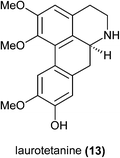 |
Actinodaphne | obovata | Leaves and branches | 13 |
| Beilschmiedia | kunstleri | Stem bark | 50 | |
| Cryptocarya | odorata | Stem bark | 51 | |
| Lindera | angustifolia | Roots | 35 | |
| benzoin | Branches | 52 | ||
| Litsea | cubeba | Stem bark | 53 | |
| sebifera | Leaves and branches | 13 | ||
| Neolitsea | sericea | Stem bark and leaves | 22 | |
| 21 | ||||
| Phoebe | chinensis | Stem bark | 46 | |
| grandis | Stem bark | 48 | ||
 |
Actinodaphne | obovata | Leaves and branches | 13 |
| Alseodaphne | perakensis | Stem bark | 41 | |
| Cryptocarya | odorata | Stem bark | 51 | |
| Lindera | angustifolia | Roots | 35 | |
| pipericarpa | Stem bark | 54 | ||
| Litsea | cubeba | 55 | ||
| cubeba | Stem bark | 53 | ||
| sebifera | Leaves and branches | 13 | ||
| Neolitsea | sericea | Stem bark and leaves | 22 | |
| 21 | ||||
 |
Aniba | muca | Stem bark | 32 |
| rosaeodora | Stem | 56 | ||
| Cinnamomum | camphora | Roots | 42 | |
| Cryptocarya | odorata | Stem bark | 51 | |
| Laurus | nobilis | Roots and aerial part | 19 | |
| Lindera | aggregata | Roots | 43 | |
| Litsea | laurifolia | Leaves | 20 | |
| leefeana | Leaves | 45 | ||
| petiolata | Stem bark | 36 | ||
| Neolitsea | acuminatissima | Stem bark | 23 | |
| sericea | Leaves | 22 | ||
| Ocotea | duckei | Stem bark and leaves | 57 and 58 | |
| vellosiana | Fruits | 31 | ||
| Phoebe | pittieri | Stem bark | 59 | |
| Sassafras | albidum | Root bark | 38 | |
 |
Cryptocarya | odorata | Stem bark | 51 |
| Dehaasia | triandra | Leaves | 60 | |
| Lindera | pipericarpa | Stem bark | 54 | |
| Litsea | cubeba | Stem bark | 53 | |
| Ocotea | macrophylla | Stem | 61 | |
| Ocotea | vellosiana | Fruits | 31 |
The most frequently detected alkaloids in Lauraceae belong to the aporphinic group, with only one benzyltetrahydroisoquinoline. With methoxyls and only a few hydroxyl groups located at positions 1, 2, 8, 10 or 11, these alkaloids have similar structures and polarities: actinodaphnine (8), dicentrine (9), isoboldine (10), laurolitsine (norboldine) (11), boldine (12), laurotetanine (13) and N-methyllaurotetanine (14). The alkaloids actinodaphnine (8) and dicentrine (9) present a dioxymethylene at C-1 and C-2, whereas reticuline (15), a benzyltetrahydroisoquinoline alkaloid, also has two hydroxyls at C-7 and C-11, two methoxyls at C-6 and C-10 and a methyl at the nitrogen atom. Among the aporphine structures, actinodaphnine (8), laurolitsine (11), boldine (12), laurotetanine (13) and N-methyllaurotetanine (14) present a hydroxyl at C-9. Laurolitsine (11) has a methyl at C-10, whereas laurolitsine (11), boldine (12), laurotetanine (13), N-methyllaurotetanine (14) and isocorydine (16) have a methoxyl at C-1. Laurolitsine (11) and boldine (12) have a hydroxyl at C-2, and laurotetanine (13), N-methyllaurotetanine (14) and isocorydine (16) have a methoxyl at C-2.
Stem bark is the most common plant part where these alkaloids can be found in Lauraceae, together with leaves. Several studies have found these alkaloids in roots as well. Taking into account that almost all of these species are trees and not shrubs, it is important to note that the preference of performing a phytochemical study on roots indicates an objective approach based on a characteristic of the family.
Some of these alkaloids have been pharmacologically studied with promising activities for use in different health areas. High cytotoxicity was observed for actinodaphnine (8) using the Mel-5 and HL-60 cell lines.16 This alkaloid also induced apoptosis in the human hepatoma cells Mahlavu by increasing nitric oxide and reactive oxygen species and modulating NF-κB signalling.18
Dicentrine (9) showed cytotoxic activity in the HCE-6, Molt-4, CESS, HL60, K562 and MS-G2 cell lines.25 Hoet et al.62 observed that dicentrine (9) presented activity against Trypanosoma brucei using in vitro assays. Recently, it was observed that this alkaloid has an antinociceptive effect following a pain stimulus (acetic acid) in experiments with mice.30 This alkaloid also presented potent vasorelaxation in experiments conducted in mice, where the IC50 ranged from 0.08 to 2.48 μM.17
Laurolitsine (11) showed cytotoxic activity against the Hep-2 cell line.46 This substance also presented significant inhibitory activity against type I HIV integrase with an IC50 of 16.3 μM.44 Antiplasmodial activity against Plasmodium falciparum (clone 3D7) was also reported for this substance with an IC50 of 1.49 mg mL−1.63
Boldine (12) showed antiinflammatory activity using a model of the oedema induced by carrageenan, in addition to antinociceptive activity.64,65 This compound has also shown cytotoxic activity against Hep-2 tumour cells with total inhibition of the cell culture at a concentration of 0.3 mg mL−1.66
Morais et al.67 performed neuropharmacological studies carried out with reticuline (15) in mice, observing that this alkaloid caused changes in sleep behaviour, motor coordination and conditioned avoidance responses in these animals, suggesting that this alkaloid possesses potent central nervous system depressant effects. Dias et al.68 observed a blood pressure-lowering effect in rats, and Medeiros and coworkers58 observed that this molecule induces vasorelaxation through the blockade of L-type Ca2+ channels.
The similarity of these substances and their pharmacological activities strongly indicates that further studies must be performed. These alkaloids are commonly obtained in very small quantities. Isolation on the gram scale would allow additional pharmacological experiments.
In addition to these substances, which are the most common alkaloids found in Lauraceae, there have been many other isoquinoline alkaloids described, with more restricted distribution. The genus Ocotea is one of the most studied in Lauraceae, with several alkaloids found, predominantly aporphines. In Ocotea macropoda, dicentrine (9), together with predicentrine (17, Fig. 2), ocopodine (18), nordicentrine (19), dehydrodicentrine (20), dehydroocopodine (21) and dicentrinone (22), was identified.69,70 In O. macrophylla, isocorydine (16), (+)-natenine (23), glaucine (24) and dehydronantenine (25) were identified.61
In recent studies performed on O. macrophylla leaves, the alkaloids dicentrine (9), (+)-nantenine (23), dehydronantenine (25), (+)-neolitsine (26, Fig. 3), (+)-N-acetyl-nornantenine (27), (+)-cassythidine (28) and didehydroocotein (29)28 were isolated. From the stem, the alkaloids (S)-3-methoxynordomesticine (30), (S)-N-ethoxycarbonyl-3-methoxynordomesticine (31), (S)-N-formyl-3-methoxynordomesticine (32) and (S)-N-methoxycarbonyl-3-methoxynordomesticine (33) were also detected and identified. The alkaloid (S)-3-methoxynordomesticine (30) showed moderate antifungal activity against Fusarium oxysporum f. sp. lycopersici and antimicrobial activity towards Staphylococcus aureus 6538 and Enterococcus faecalis 29212.71 (+)-Nantenine (23) has also presented a reversible effect in muscle contraction and Ca2+ transients in experiments using rats.72
Extracts from the leaves of O. brachybotra yielded the alkaloids dicentrine (9), predicentrine (17), ocopodine (18), (±)-glaziovine (34, Fig. 4), cassythicine (35), leucoxine (36) and sinacutine (37). In the same study, the authors isolated morphinone derivatives such as pallidine (38), ocobotrine (39) and 14-episiomenine (40). Their structures were elucidated by the usual spectroscopy methods and chemical correlations.26
A great number of isoquinoline alkaloids have been reported in other species of Ocotea, including (+)-isoboldine (10), (−)-zenkerine (41, Fig. 5), (+)-laurelliptine (42), (−)-pulcine (43) and nororientidine (44), observed in O. caesia stems,37 and 1-(p-methoxybenzoyl)-6,7-methylenedioxyisoquinoline (45), 1-(hydroxy-p-methoxybenzyl)-6,7-methylenedioxyisoquinoline (46), 1,2-dihydro-1-(p-methoxybenzoyl)-6,7-methylenedioxy-isoquinoline (47) and 1,2-dihydro-1-(hydroxy-p-methoxybenzyl)-6,7-methyl-enedioxyisoquinoline (48), obtained from O. pulchella stem bark.73
In Ocotea vellosiana, the alkaloids predicentrine (17), nordicentrine (19), ocoteine (49, Fig. 6), O-methylcassyfiline (50), leucoxylonine (51), ocotominarine (52) and reticuline (15) were detected in the branches; ocopodine (18) and ocominarine (53) in the leaves; glaucine (24), isocorydine (16) and corydine (54) in the fruits; and dicentrine (9) were identified in all plant parts studied.31 In Ocotea duckei were isolated the benzylisoquinoline alkaloids reticuline (15) from the leaves and stem bark58,67 and coclaurine (55) from the stem.74 Several aporphine structures were isolated from O. minarum leaves, which were identified as dicentrine (9), predicentrine (17), ocopodine (18), dicentrinone (22), leucoxine (36), ocoteine (49), leucoxilonine (51), ocotominarine (52), ocominarine (53), thalicminine (56), norleucoxilonine (57), isooconovine (58), 4-hydroxydicentrine (59) and ocominarone (60). Structure identification was performed by spectroscopy methods and chemical correlations.27
Investigations on O. glaziovii leaves have afforded assimilobine (61, Fig. 7), caaverine (62), liridinine (63) and glaziovine (34);75 these compounds were also observed in O. variabilis.76 This species has also shown the presence of nantenine (23), apoglaziovine (64) and variabiline (65).76 In the species O. sinuata, nordomesticine (66) was found, while isocorydine (16), taliporfine (67), oconovine (68), ococriptine (69), ocoxilonine (70) and hernandonine (71) were identified in Ocotea, but without species recognition.69,77,78
A number of alkaloid structures have been elucidated in O. puberula: dicentrine (9), N-methyllaurotetanine (14), predicentrine (17), leucoxine (36), ocoteine (49), talicminime (56), isodomesticine (72, Fig. 8), dicentrine-N-oxide (73), dehydroocoteine (74), didehydroocoteine (75) and 3-hydroxydicentrine (76).69,79–81 Further studies on the seedling leaves of Ocotea puberula have yielded dicentrine (9), boldine (12), leucoxine (36) and isodomesticine (72), in concentrations higher than those observed in the leaves of adult individuals.29 The methanolic extract of O. leucoxylon yielded dicentrinone (22) as the major alkaloid besides dicentrine (9) and leucoxylonine (51).82 In the leaves of O. holdridgeiana, isocorydine (16), O,O-dimethylcorituberine (77), 3-hydroxynuciferine (78) and 3-methoxynuciferine (79) were identified.83
López and coworkers84 obtained the alkaloids isocorydine (16), 3-hydroxynuciferine (78) and 3-hydroxy-6a,7-dihydronuciferine (80, Fig. 9) from ethanolic extracts of O. brenesii leaves. Studies performed with O. acutangula leaves led to the identification of (S)-(−)-pallidine (38), its derivative (S)-(−)-O-methylpallidine (81), as well as the alkaloids (S)-(−)-pallidinine (82) and (S)-(−)-O-methylpallidinine (83).85
From O. rodiaei stem bark, the structures of the alkaloids rodiasine (84, Fig. 10), ocoteamine (85), demerarine (86), norrodiasine, dirosine, otocamine and ocodemerine were elucidated.86 Other alkaloids found in the genus Ocotea are talbaicalidine (87) in O. bucherii,87 talictuberine (88) and 3-O-dimethyltalictuberine (89) in O. insularis.88
Most of these references on the Ocotea genus addressed are mentioned in the review about Ocotea aporphine alkaloids presented by Zanin and Lordello,3 in which the authors reported the occurrence of 54 aporphine alkaloids distributed in 17 species, including 39 aporphines, four oxoaporphines, five 6a,7-dehydroaporphines, one didehydroaporphine, one C-3-O-aporphine, one C-4-O-aporphine, two phenanthrenes and one proaporphine.
Recently, the alkaloids (+)-neolitsine (26), (+)-6S-ocoteine-N-oxide (90, Fig. 11), (+)-norocoxilonine (91) and (+)-talicsimidine (92) were isolated from the leaves and stem bark of Ocotea acutifolia.89
In Cryptocarya, several isoquinoline alkaloids have also been found. However, this genus presents several unusual pavine alkaloids. Among the exceptions are armepavine (93, Fig. 12), a benzylisoquinoline alkaloid obtained from Cryptocarya archboldiana leaves that represents 70% of the alkaloidal fraction obtained.90 Other alkaloids present in the genus are (+)-orientaline (94) and laudanidine (95) in the stem bark of C. amygdalina,91 ateroline (96) and velucryptine (97) in C. velutinosa leaves92 and (+)-(1R,1Ra)-1a-hydroxymagnocumarine (98) from C. konishii.93 Lisicamine (99) was isolated from the stem bark of Cryptocarya strictifolia.94 In C. odorata stem bark, laurotetanine (13), N-methyllaurotetanine (14), reticuline (15), isocorydine (16) and cryptodorine (100) were found.51 From C. phyllostemom stem bark, two tetrahybenzylisoquinoline alkaloids, (+)-phyllocryptine (101) and (+)-phyllocryptonine (102) were obtained.95
The study of C. ferrea stems led to the isolation of three aporphine alkaloids: (−)-O-methylisopiline (103, Fig. 13), (+)-lirioferine (104) and (+)-norlirioferine (105).96 Seven benzylisoquinoline alkaloids were obtained from C. rugulosa stem bark: (+)-reticuline (15), papraline (106), (+)-norcinnamolaurine (107), (+)-codamine (108), (+)-6-methoxy-1-(3′-methoxybenzyl)-N-methyl-7-isoquinolinol (109), (−)-N-methylisococlaurine (110) and (+)-reticuline-N-oxide (111).97
Cryptocarya chinensis is one of the most studied in this genus, with several alkaloids identified: isoboldine (10), (±)-romneine (112, Fig. 14), (−)-eschscholtzine (113), (+)-eschscholtzidine (114),98 (−)-isocaryachine-N-oxide (115), isoboldine-β-N-oxide (116), 1-hydroxycryprochine (117), (+)-isocaryachine (118), (+)-caryachine (119), (−)-caryachine (120), (−)-isocaryachine (121), (−)-munitagine (122), bisnorargeminine (123),34 all of them isolated from the leaves of this species.
C. chinensis stems have yielded the pavine alkaloids (+)-eschscholtzidine (114), (+)-caryachine (119), (+)-escholtzidine-N-oxide (124, Fig. 15), (−)-12-hydroxyeschscholtzidine (125), (−)-12-hydroxycrychine (126), (−)-N-demethylcrychine (127), neocaryachine (128), crychine (129), (−)-argemonine (130), dorianine (131), (−)-N-demethyl-phelocryptine (132), in addition to the proaporphines cryprochine (133), isocryprochine (134), prooxocryptochine (135), isoamuronine (136) and (+)-8,9-dihydroestepharine (137).99
From the stem bark, (−)-eschscholtzidine (114), 1-hydroxycryprochine (117), (+)-caryachine (119), (−)-caryachine (120), (−)-isocaryachine (121), (−)-neocaryachine (128), (+)-cryprochine (133), (−)-isocaryachine-N-oxide B (138, Fig. 16), (−)-caryachine-N-oxide (139), 6,7-methylenedioxy-N-methylisoquinoline (140), (+)-isocaryachine-N-oxide (141), (+)-cinnamolaurine (142), (−)-mutagenine, 4-(6,7)-dimethyloxyisoquinoline-1-ylmethylphenol, (−)-2-O-norargemonine and (−)-N,N-dimethylcaryachine were isolated,98,100,101 in addition to three quaternary pavine alkaloids N-methoxy salts of caryachine (143), neocaryachine (144) and crychine (145) isolated from C. chinensis callus culture.102 Caryachine was also obtained as an N-methoxy salt (143) by Chen et al.103 from the stem bark of C. chinensis.
A number of isoquinoline alkaloids have been reported in the genus Cassytha; the most studied species is Cassytha filiformis. Several alkaloids have been described to this species, including neolitsine (26), cassythidine (28), O-methylcassyfiline (=O-methylcassythine) (50), cassyfiline (=cassythine) (146, Fig. 17), lisicamine (99), cassamedine (147), cassameridine (148), launobine (149), bulbocapnine (150), (+)-nornuciferine (151), (+)-nuciferine (152), aterospermidine (153), liriodenine (154), O-methylateroline (155), catafiline (156), cataformine (157), isofiliformine (158), cassythic acid (159), norpredicentrine (160), (−)-O-methylflavinatine (=sebiferine) (161), (−)-salutaridine (162) and 1,7-methylenedioxy-3,10,11-trimethoxyaporphine (163).14–17
In Cassytha pubescens, the aporphine alkaloids isoboldine (10), nantenine (23), laurelliptine (42), nordomesticine (66), domesticine (164, Fig. 18) and sinoacutine (165) were identified.33 Tsai and coworkers17 observed in this species dicentrine (9), neolitsine (26), cassythine (146) and cassythic acid (159). Cassythine (146) showed high activity against the cell lines Mel-5 (IC50 of 24.3 μM) and HL-60 (IC50 of 19.9 μM) and was also active in in vitro assays with Trypanosoma brucei.16,62 Cytotoxic activity of neolitsine (26) was also observed in the cancer cell lines HeLa and 3T3 with an IC50 of 21.6 μM and 21.4 μM, respectively.16
Investigations into Aniba species afforded (R)-(+)-noranicanine (166, Fig. 19), a benzylisoquinoline trioxygenated alkaloid that was isolated from the stem bark of Aniba canellila.104 Eleven other benzyltetrahydroisoquinoline alkaloids were also reported in this species, including four compounds monosubstituted on ring C with a hydroxyl at C-11, i.e. (−)-norcanelilline (167), (+)-canelilline (168), anicanine (169) and canelillinoxine (170); two compounds monosubstituted at C-9 in ring D, i.e. (−)-anibacanine (171) and (+)-manibacanine (172); two compounds monosubstituted at C-11 in ring D, i.e. (−)-pseudoanibacanine (173) and (+)-pseudoanibacanine (174); and three alkaloids with the same substitution pattern on rings A and B with a methyl group at positions 8α and 8β, i.e. (−)-α-8-methylpseudoanibacanine (175), (−)-β-8-methylpseudoanibacanine (176) and (−)-α-8-methylanibacanine (177).105 Additionally, isoboldine (10), reticuline (15) and N-methylcoclaurine (178) were isolated from Aniba muca stem bark.32 Reticuline (15) was also found in Aniba rosaeodora.56
In the genus Lindera, lindecarpine (179, Fig. 20) and N-methyllindecarpine (180) have been reported in Lindera pipericarpa roots,106 and N-methyllaurotetanine (14), isocoridine (16) and norisocoridine (181) in the stem bark.54 The bisbenzylisoquinoline dimer lindoldhamine (182) was isolated from leaves of L. oldhamii.107 D-Dicentrine (9) was observed in L. megaphylla roots,25 while laurotetanine (13) was obtained from L. benzoin branches.52 The alkaloids laurolitsine (11), hernandine (183), hernangerine (184), N-methylhernangerine (185), ocokryptine (N-methylhernandine) (186), hernandonine (187), 7-oxohernangerine (188), lindechunine A (189), lindechunine B (190) and 7-oxohernagine (191) were isolated from the roots of L. chunii.44 Among the alkaloids found in L. chunii significant inhibitory activity against type I HIV integrase was observed for hernandonine (187), 7-oxohernangerine (188) and lindechunine A (189) with IC50 of 7.7 μM, 18.2 μM and 21.1 μM, respectively.44
More recently, some common aporphine alkaloids were observed in L. angustifolia roots, such as isoboldine (10), norboldine (11), boldine (12), laurotetanine (13), N-methyllaurotetanine (14), reticuline (15), norisocoridine (181), and N-ethoxycarbonyllaurotetanine (192, Fig. 21), in addition to magnocurarine (193).35 In L. aggregata, the alkaloids laurolitsine (11), boldine (12), reticuline (15), (−)-pallidine (38), norisocoridine (181), linderaline (194), protosinomenine (195), laudanosoline 3′,4′-dimethylether (196), norisoboldine (197) and pronuciferine (198), together with the bisbenzylisoquinoline linderegatine (199) were isolated from the ethanolic extract of the roots.43,108 Among these alkaloids, norisoboldine (197) has been reported to inhibit the production of proinflammatory cytokines in experiments with mouse macrophage cell lineage RAW 264.7.43,109 For norisocoridine (181), antinociceptive activity and a high capacity for sequestering free radicals with an SC50 of 14.1 mg mL−1 have been found.65
A number of structures are related to the genus Litsea, among then litebamine (200, Fig. 22), a phenanthrene alkaloid observed in L. cubeba stems, with the structure 3,7-dihydroxy-4,6-dimethoxy-N-methyl-tetrahydropyride [4,3-a]phenanthrene,110 N-methyllaurotetanine (14) and the quaternary alkaloids (−)-magnocurarine (193), (−)-oblongine (201), (−)-8-O-methyloblongine (202) and xantoplanine (203).55,93 L. cubeba stem bark yielded five new isoquinoline alkaloids, i.e. (+)-N-(methoxycarbonyl)-N-nordicentrine (204), (+)-N-(methoxycarbonyl)-N-norpredicentrine (205), (+)-N-(methoxycarbonyl)-N-norglaucine (206), (+)-N-(methoxycarbonyl)-N-norbulbodione (207), (+)-N-(methoxycarbonyl)-N-norisocorydione (208) and (+)-8-methoxyisolaurenine-N-oxide (209), all obtained from the 70% ethanolic extract.111 The alkaloids (+)-N-(methoxycarbonyl)-N-nordicentrin (204), (+)-N-(methoxycarbonyl)-N-norpredicentrine (205) and (+)-N-(methoxycarbonyl)-N-norglaucine (206) showed antimicrobial activity against the bacteria S. aureus and two fungi, A. alternata and C. nicotianae, while (+)-N-(methoxycarbonyl)-N-norbulbodione (207) and (+)-N-(methoxycarbonyl)-N-norisocorydione (208) exhibited significant cytotoxicity against six tested tumour cell lines.111 Other alkaloids found in the stem bark of this species were (+)-laurotetanine (13), N-methyllaurotetanine (14) and isocorydine (16).53
Some well-known alkaloids were also found in species of Litsea, such as isoboldine (10), laurelliptine (42) and liriodenine (154) in L. glutinosa leaves,112 actinodaphnine (8), boldine (12), laurotetanine (13) and N-methyllaurotetanine (14) in L. sebifera leaves and branches, norboldine (laurolitsine) (11) and boldine (12) in L. wightiana stem bark13 and laurolitsine (11), boldine (12) and (+)-reticuline (15) in L. leefeana leaves.45
A study on Litsea laurifolia led to the isolation of laurolitsine (11) from the bark and actinodaphnine (8), reticuline (15) and glaziovine (34) from the leaves.20 From Litsea laeta stem bark, the alkaloids glaucine (24), laetanine (210, Fig. 23), laetine (211) and N,O-dimethylharnovine (212) were isolated.113,114 In the same study, the authors isolated nordicentrine (19) and dicentrinone (22) from the leaves of Litsea salicifolia. Barbosa-Filho et al.64 listed several alkaloids with antiinflammatory activity, including glaucine (24). Recently, a new bisbenzylisoquinoline alkaloid, lancifoliaine (213), was isolated from the stem bark of Litsea lancifolia, along with seven other known alkaloids: actinodaphnine (8), norboldine (11), boldine (12), reticuline (15), cassythicine (35), pallidine (38) and N-alyllaurolitsine (214).115 The alkaloids isoboldine (10), reticuline (15) and thalifoline (215) were isolated from L. petiolata bark.36
In the genus Neolitsea, the alkaloids actinodaphnine (8), isoboldine (10), laurolitsine (11), boldine (12), reticuline (15), (−)-talicsimidine (92), (+)-cassythine (146), liriodenine (154), (+)-O-methylflavinatine (=sebiferine) (161), neolitacumonine (216, Fig. 24), (−)-norushinsunine (217), N-methylactinodaphnine (218), (−)-anonaine (219) and oxogalucine (220) were isolated from the stem bark of N. acuminatissima.23 In Neolitsea sericea stems and leaves, actinodaphinine (8), isoboldine (10), laurolitsine (11), boldine (12), laurotetanine (13), N-methyllaurotetanine (14), reticuline (15), N-oxides of reticuline (111), norisocoridine (181), N-methylactinodaphinine (218), L-roemerine (221), litsericine (222), N-oxides of pallidine (223), boldine (224), juziphine (225) and N-methyllaurotetanine (226) were found, as well as (+)-corituberine (227).21,22,116–120 In the stem bark of Neolitsea variabillima, L-hernovine (228), L-nandigerine (229) and L-N-methylhernovine (230) were found.121
Among the isoquinoline alkaloids described in the genus Phoebe, laurolitsine (11), liriodenine (oxoushinsunine) (154), roemerine (221), ushinsunine (231, Fig. 25) and laurodionine (232) were isolated from the bark and stem of Phoebe formosana,47,122 and some pentasubstituted aporphines were found in the bark of Phoebe molicella, i.e. norpurpureine (233), purpureine (234), preocoteine (235) and norpreocoteine (236).123 From the leaves of Phoebe pittieri, the alkaloids lirioferine (104) and norlirioferine (105) were obtained.124 Reticuline (15), norlirioferine (105), norpurpureine (233) and 1,2,3-trimethoxy-9,10-methylenodioxinorarporphine (237) were isolated in the bark of the same species.59 In P. chinensis, several compounds with aporphine skeletons were obtained from the stem bark, including laurolitsine (11) and laurotetanine (13), very common structures in Lauraceae, as well as caaverine (62), liriodenine (154), sebiferine (=O-methylflavinatine) (161), anonaine (219) and roemerine (221).46
In Phoebe grandis, the phoebegrandines A (238, Fig. 26) and B (239), as well as phoebegrandine C, D and E were isolated from the leaves, while norboldine (11), boldine (12), laurotetanine (13), lindecarpine (179), (−)-grandine A (240), (−)-8,9-dihydrolinearisine (241), scortechiniines A and B (242) and lauroformine (243) were obtained from the stem bark.48,125–127 In P. lanceolata stem bark, the alkaloids laurodionine (232) and nordelporphine (244) were identified, and were also observed in P. formosana stem bark.122,128,129 In Phoebe scortechinii leaves, the dimer tryptamine proaporphine, (−)-phoebescortechiniine and phoebegrandines A (238) and B (239) were found,130 while in the stem the aporphine norboldine (11) as well as the proaporphine alkaloids (+)-scortechiniine A and B (242), (−)-hexahydromecambrine A (245) and (−)-norhexahydromecambrine A (246) were identified.49 Antiplasmodial activity against Plasmodium falciparum (clone 3D7) was reported for the alkaloids isolated from the stem bark of P. tavoyana, i.e. sebiferine (161) and roemerine (221), with IC50 values of 2.76 mg mL−1 and 0.89 mg mL−1, respectively.63
Investigations into Dehaasia triandra afforded isocorydine (16) in the leaves, and some bisbenzylisoquinoline structures, including obaberine (247, Fig. 27), norobaberine (248), 3′,4′-dihydrostafasubine (249) and norisotetrandrine (250) were detected in stems of D. triandra.60,131,132 Mukhtar et al.133 studied the leaves of Dehaasia longipedicellata and isolated five morfinandienone alkaloids, including (−)-pallidine (38), (+)-pallidinine (82), (−)-sinoacutine (165), (+)-milonine (251) and (−) 8,4-dehydrosalutaridine (252).
From the stem bark of Actinodaphne pruinosa a new alkaloid was isolated, (+)-N-(2-hydroxypropyl)lindecarpine (253, Fig. 28), which showed cytotoxicity against P-388 leukaemia cells with an IC50 of 3.9 μg mL−1.40 Additionally, the alkaloids (+)-norboldine (11), (+)-boldine (12), (+)-lindecarpine (179) and (+)-methyllindecarpine (180) were obtained.40 In A. sesquipedalis, the presence of dicentrine (9) was reported in the stem bark,24 while in A. nitida laurolitsine (11) and boldine (12) were found in the stem bark and leaves.39
Two morphinandienone structures were obtained from Beilschmiedia oreophila stems and bark, i.e. oreobiline (254, Fig. 29) and 6-epioreobiline.134 From B. brevipes leaves, the benzylisoquinoline alkaloids (6,7-dimethoxy-4-methylisoquinolinyl)-(4′-methoxyphenyl)-metanone (255) and O,O-dimethylannocherine (256) were obtained.135 Recently, in Beilschmiedia kunstleri, the alkaloids (+)-norboldine (11), (−)-pallidine (38) and (+)-N-methylisococlaurine (257) from leaves; (−)-isocaryachine (121), (+)-nornuciferine (151), noraterosperminine (258) and (+)-N-demethylphyllocaryptine (259) were isolated from stem bark; (+)-boldine (12), (+)-laurotetanine (13) and (+)-cassythicine (35) were obtained from vegetal parts.50,136
In the genus Machilus, the alkaloid (+)-L-reticuline (15) was found in M. thumbergii, D,L-coclaurine (55) in M. kusanoi and M. macranta; (+)-L-laudanidine (95) in M. obovatifolia and M. arisanensis; (−)-L-N-noramepavine (260, Fig. 30) in M. kusanoi, M. pseudolongifolia, M. thumbergii, M. obovatifolia, M. arisanensis and M. zuihoensis; D,L-N-norarmepavine (261) in M. pseudolongifolia, M. thumbergii, M. obovatifolia, M. arisanensis and M. zuihoensis.137–142 From M. glauscescens leaves, the oxoaporphine alkaloids machigline (1,2-methylenedioxy-9-hydroxy-10-methoxyoxoaporphine) (262) and ateroline (96) were obtained.143
Studies performed on Alseodaphne species led to the identification of (+)-reticuline (15), a mixture of coclaurine (55) isomers in a proportion of 3![[thin space (1/6-em)]](https://www.rsc.org/images/entities/char_2009.gif) :
:![[thin space (1/6-em)]](https://www.rsc.org/images/entities/char_2009.gif) 1 ((+)-coclaurine–(−)-coclaurine) and (−)-N-norarmepavine (261) in A. archboldiana,144 whereas in A. semicarpifolia, the C-4 hydroxylated aporphine srilankine (263, Fig. 31) was obtained.145 In A. corneri stem bark, a new bisbenzylisoquinoline alkaloid, 3′,4′-dihydronorstephasubine (264), together with two known structures, norstephasubine (265) and girolidine (266), were found; moderate vasorelaxation effects were identified for 264 and 266 in rat aorta assays.146 From the roots of the same species, the bisbenzylisoquinoline alkaloids norstephasubine (265), (−)-girolidine (266), (+)-norlimacusine (267) and (+)-stephasubine (268) were isolated.147
1 ((+)-coclaurine–(−)-coclaurine) and (−)-N-norarmepavine (261) in A. archboldiana,144 whereas in A. semicarpifolia, the C-4 hydroxylated aporphine srilankine (263, Fig. 31) was obtained.145 In A. corneri stem bark, a new bisbenzylisoquinoline alkaloid, 3′,4′-dihydronorstephasubine (264), together with two known structures, norstephasubine (265) and girolidine (266), were found; moderate vasorelaxation effects were identified for 264 and 266 in rat aorta assays.146 From the roots of the same species, the bisbenzylisoquinoline alkaloids norstephasubine (265), (−)-girolidine (266), (+)-norlimacusine (267) and (+)-stephasubine (268) were isolated.147
Among the alkaloids described in Alseodaphne perakensis, N-methyl-2,3,6-trimethoxymorphinandien-7-one (269, Fig. 32) has been described as the main alkaloid in leaves, along with a mixture of other alkaloids in small quantities, including N-methyl-2,3,6-trimethoxymorphinandien-7-one-N-oxide (270).148,149 From the stem bark of the same species, the alkaloids α′-oxoperakensimines A (271), B (272) and C (273) were isolated. In the same study, vasorelaxation activity was also reported for both substances using rat aorta assays.150 Recently, a new alkaloid in this species was observed, also present in the stem bark, i.e. N-cyanomethylnorboldine (274), in addition to the known structures, N-methyllaurotetanine (14) and norboldine (11).41
Some genera of Lauraceae have had a few reports regarding the occurrence of alkaloids in their species. For example, in Sassafras albidum root bark, common structures in Lauraceae, such as isoboldine (10), norboldine (11), boldine (12) and reticuline (15) have been described, as well as norcinnamolaurine (107) and cinnamolaurine (142).38 Coclaurine (55), norcinnamolaurine (107) and corituberine (227) were isolated from the stems of Mezilaurus synandra.151 Le Quesne et al.152 obtained laurelliptine (42), an aporphine alkaloid, from the leaves and branches of Nectandra rigida. In Ravensara aromatica stem bark, the quaternary chloride base of N-methylisocorydine (275, Fig. 33) was observed.153 From the ethanolic extract of Pleurothyrium cinereum leaves, the oxoaporphines thalicminine (56) and pleurotirine (276) were isolated.154
A number of common Lauraceae alkaloids have been found in Laurus nobilis, such as (+)-actinodaphinine (8), (+)-boldine (12), (+)-reticuline (15), (+)-neolitsine (26), (+)-isodomesticine (72), (+)-cryptodorine (100), (+)-launobine (149), (+)-N-methylactinodaphinine (218), (+)-nandigerine (229), (+)-norisodomesticine (277, Fig. 34) from the leaves; actinodaphnine (8), reticuline (15) and launobine (149) from the branches; and actinodaphnine (8), (+)-reticuline (15), (+)-launobine (149) and (+)-nandigerine (229) from the roots.19
Three related alkaloids were found in Licaria arminiaca stem bark, i.e. bracteoline (278, Fig. 35), O-methylbracteoline and α-dehydroreticuline (279); this was the first report of these structures in this genus.155
3 Indole alkaloids
The indole substances reported in Lauraceae include cecilin (280, Fig. 36), a β-carboline alkaloid isolated from the trunk of Aniba santalodora156 and triptophol-5-O-β-D-glycopiranoside (281), obtained from Ocotea minarum fruits.157In Litsea petiolata, two indole alkaloids were isolated from the bark, identified as aribine (=harmane) (282, Fig. 37) and norharmane (283).36 Other β-carboline structures, i.e. the daibucarbolines A (284), B (285) and C (286), were obtained from Neolitsea daibuensis roots. In the same study, moderate antiinflamatory activity of daibucarboline A (284) was observed due to the inhibition of nitrite-producing cell lines, with an IC50 of 18.41 μM.158
4 Pyridine alkaloids
Pyridine type alkaloids have been observed in Lauraceae, but with less frequency, as well as some indole alkaloids. In Aniba rosaeodora, the presence of two tertiary structures, anibine (287, Fig. 38)159 and duckein (288),160 has been reported, both obtained from the stem. Anibine (287) was also found in Aniba fragrans stems;161 this alkaloid was reported to possess analeptic activity.1625 Other classes of alkaloids
Besides isoquinoline, indole and pyridine alkaloids, the Lauraceae family also presents some other less common skeletons. Criptopleurine (289, Fig. 39), a phenanthroquinolizidine, was observed in C. laevigata and showed good activity against human nasopharyngeal epidermoid carcinoma (KB) cells with an IC50 of 5.10 mg mL−1.163 The indolizidine quaternary alkaloid anibamine, elucidated as 6,8-didec-(1Z)-eni-5,7-dimethyl-2,3-dihydro-1H-indolizidine (290), was obtained from Aniba panurensis as a salt of trifluoroacetic acid164 and from another Aniba species.165Dibenzopyrrolidine alkaloids cryptowoline (291, Fig. 40), O-methyl-cryptowoline (292), cryptowolinol (293) and cryptowolidine (294) were observed in Cryptocarya phyllostemon stem bark, while cryptaustoline (295) and cryptowolinol (293) were obtained from Cryptocarya oubatchensis stem bark and leaves.166 In Litsea cubeba, two dibenzopyrrolidine structures, i.e. (−)-litcubine (296) and (−)-litcubinine (297), were isolated.167
Andrianaivoravelona et al.168 isolated a tryptamine-derived alkaloid in a methanolic extract from the stem bark of Ravensara anisata, N-(p-coumaroyl)-tryptamine (298, Fig. 41).
In Aniba riparia, the N-benzoyltyramines riparin I (299, Fig. 42), riparin II (300) and riparin III (301) were isolated.169 Antimicrobial activity was reported for all three substances,170 as well as antinociceptive activity for riparin I (299),171 anxiolytic activity for riparin II (300) and III (301), and antidepressant activity for riparin III (301), dependent on its interaction with serotonergic, noradrenergic and dopaminergic systems.172–175 Castelo-Branco et al.176 observed in pharmacological studies that the riparins I (299), II (300) and III (301) induced relaxation of contractions in guinea pig ileum and rat uterus produced by acetylcholine and histamine and oxytocin and bradykinin, respectively.
In a study performed on Machilus yaoshansis stem bark, two triterpene glycosylated alkaloids were isolated, machilaminoside A (302, Fig. 43) and machilaminoside B (303), as new substances in this species.177
Alkaloids receive great attention in research on natural products due to the variety of pharmacological activities they possess, which makes them indispensable ingredients for new drugs.178 However, it is often infeasible to obtain these substances from their natural sources due to the low yields observed in extractions.179 Even when it is possible to obtain them on a large scale from natural sources, high solvent consumption and length of time required make the process impracticable.179 Thus, the synthesis of alkaloids has been a promising alternative for obtaining them, with several established routes, including procedures of metabolic engineering and biocatalysis.180–183
Among the alkaloids observed in Lauraceae family, the synthesis of some structures is already described in the literature, such as that of actinodaphnine, boldine and isocorydine.184–186 Techniques employing microorganisms to obtain molecules of interest are also reported, such as obtaining reticuline from simple carbon sources employing Escherichia coli and by fermentation of dopamine using Saccharomyces cerevisiae.187–189 Some of these alkaloids are still used in the semi-synthesis of more complex alkaloids like litebamine and glaucine from boldine.190,191
Combined molecular modelling and synthesis is an important tool in achieving most active alkaloids and derivatives in bulk. Studies of isoquinoline alkaloids, often reported in Lauraceae, showed that some structural characteristics favour the presence of pharmacological activity. Among them it was observed that replacement of hydroxyl by methoxyl groups, aromatization of the C-ring in protoberberine alkaloids and quaternary nitrogen all contribute to the increase of antipoliovirus, antiviral and acetylcholinesterase inhibitory activities of the alkaloids.192,193 Moreover, the presence of 1,2-methylenedioxy groups and substituted groups in nitrogen appear to contribute to reduced alkaloid activity.192,193
6 Conclusion
According to the data presented here, it can be seen that the Lauraceae family presents a great number of alkaloids of wide variety, with over 300 structures in 21 genera described in the literature. Isoquinoline alkaloids are reported as the major class, with about 287 compounds, as well as seven indoles, seven dibenzopyrrolidines, three pyridines, three benzoyltyamines, two glycoside triterpene alkaloids, one phenanthroquinolizidine, one indolizidine and one tryptamine derivative. The isoquinoline alkaloids are present in all genera reported in this review, and represent the major class in Lauraceae. However, other classes are reported in this family, some with only a few structures restricted to a specific genus.Concerning the indole alkaloids, one structure has been mentioned in Aniba santalodora, one in Ocotea minarum, two in Litsea petiolata and three in Neolitsea daibuensis. Another class present in Lauraceae is the pyridine alkaloids, represented by two structures restricted to Aniba rosaeodora. Among the dibenzopyrrolidines, five structures are present in Cryptocarya oubatchensis and Cryptocarya phyllostemon and two have been reported in Litsea cubeba. Other alkaloid classes are also present in Lauraceae, such as the N-benzoyltyramines riparins I, II and III, observed in Aniba riparia, an indolizidine in Aniba panurensis, a quinolizidine in Cryptocarya laevigata, a tryptamine derivative in Ravensara anisata and two glycoside triterpene alkaloids in Machilus yaoshansis.
In order to evaluate a possible grouping taxonomic effect on the alkaloid composition, hierarchical cluster analysis (HCA) was performed using R software, version 3.0.1. Alkaloid frequency was analysed in the species according to data in the literature. In the HCA analysis, classes were separated into two groups. The first group was formed by Ocotea grouping with other genera that present major isoquinoline alkaloids, including Cassytha, Lindera and Phoebe (Fig. 44). These genera that have only isoquinoline alkaloids of different subclasses are soon expected to be grouped. The genus Ocotea is not in this group, but it is very close to it since this genus also presents an indole structure and several isoquinolines.
The second largest group is formed by genera that present other classes besides isoquinolines in their composition, such as Ravensara, which presents a glycoside tryptamine derivative. Litsea and Cryptocarya are grouped together due to the presence of dibenzopyrrolidine structures found in both genera. Aniba and Machilus are grouped together due the presence of exclusive alkaloid classes in their composition, since Aniba presents pyridine and benzoyltyramine structures, and Machilus contains glycoside triterpene alkaloids.
The structures reported in this review predominantly belong to the isoquinoline class, which is composed of 287 structures distributed in all genera mentioned. The isoquinoline alkaloids were separated into subclasses with 148 aporphines, 47 benzylisoquinolines, 23 pavines, 21 proaporphines, 21 bisbenzylisoquinolines, 18 morphinandienones, five simple isoquinolines and four phenanthrene (Fig. 45). There are eight common isoquinoline structures, i.e. aporphine actinodaphnine (8), dicentrine (9), isoboldine (10), laurolitsine (norboldine) (11), boldine (12), laurotetanine (13), N-methyllaurotetanine (14) and isocorydine (16), and one benzylisoquinoline, reticuline (15), that are present in several species of Lauraceae (Fig. 2).
The genus Ocotea is the most studied, with 87 alkaloids described, including 86 isoquinolines and one indole. Ocotea minarum is the species with largest number of described isoquinoline structures, with 14 aporphine alkaloids. The Ocotea alkaloids are mostly aporphines, with 62 structures. Other genera rich in aporphine alkaloids are Cassytha, Lindera, Litsea, Neolitsea and Phoebe, with 27, 22, 23 and 19 structures, respectively.
Another genus with many reported structures is Cryptocarya, with 68 alkaloids, including 62 isoquinolines, five dibenzopyrrolidines and one quinolizidine. Cryptocarya chinensis is the most studied species in this genus, with 39 structures described, among them 23 pavine skeletons, a subgroup of isoquinoline alkaloids almost restricted to the genus Cryptocarya. The pavine structure (−)-isocaryachine (121) has also been observed in Beilschmiedia kunstleri.
Benzylisoquinoline alkaloids have been reported mainly in Aniba with 14 substances. This subclass is also present in Cryptocarya species, with 15 alkaloids reported, while the proaporphines are mostly found in Phoebe, with 12 structures present in Phoebe grandis and Phoebe scortechinii. The morphidianone structures are observed in more quantity in Ocotea and Dehaasia, with eight and five structures, respectively, while the bisbenzylisoquinolines are described mainly in Alseodaphne and Ocotea, with seven structures in each genus. Small quantities of other isoquinoline subclasses have also been observed, among them four phenanthrenes, one in Beilschmiedia, one in Litsea and two in Ocotea. Simple isoquinolines have been detected in Cryptocarya and Litsea, with four and one, respectively.
Pavine structures were observed in Cryptocarya and Beilschmiedia, while Dehhasia and Alseodaphne present bisbenzylisoquinoline alkaloids in high proportions when compared with other genera that possess this type of alkaloid. The genera Aniba, Machilus and Mezilaurus contain a number of benzylisoquinoline structures. On the other hand, the genus Phoebe presents a great quantity of proaporphine alkaloids. Other genera with small quantities of proaporphine alkaloids are Ocotea, Neolitsea and Lindera, with one structure each, and Cryptocarya, with six proaporphine alkaloids.
The genera Ravensara, Pleurothyrium and Nectandra have few aporphine alkaloids, while Cassytha and Laurus have mainly aporphines and a few structures belonging to the morphinandienone and benzylisoquinoline subclasses.
There are some genera with only few alkaloids described, such as Cinnamomum, Mezilaurus, Nectandra, Pleurothyrium and Ravensara, which have one to three alkaloids each. Perhaps these genera do not possess the biosynthetic routes to alkaloids in their secondary metabolism, or they are just less studied than other genera.
Some of these substances have restricted distribution, showing the possibility of their use as chemical markers, and therefore may play an important role in chemotaxonomy. Pharmacological properties have been observed, such as the cytotoxicity of actinodaphnine (8), dicentrine (9) and boldine (12) and the antiinflammatory effect of the latter, in addition to the potent central nervous system depressant effect observed for reticuline (15).
References
- V. C. Souza and H. Lorenzi, Botânica sistemática: guia ilustrado para identificação das famílias de Angiospermas da flora brasileira, baseado em APG II, Instituto Plantarum, Nova Odessa, 2005 Search PubMed.
- The Plant List, Version 1, http://www.theplantlist.org/, accessed 8 March 2013.
- S. M. W. Zanin and A. L. L. Lordello, Química Nova, 2007, 30, 92–98 CrossRef CAS PubMed.
- P. T. B. Sampaio, I. D. K. Ferraz and I. L. C. Camargo, Manual de Sementes da Amazônia, 2003, 1–6 Search PubMed.
- L. d. F. S. Sampaio, J. G. S. Maia, A. M. de Parijós, R. Z. de Souza and L. E. S. Barata, Phytother. Res., 2012, 26, 73–77 CrossRef CAS PubMed.
- J. G. S. Maia, E. H. A. Andrade, H. A. R. Couto, A. C. M. Silva, F. Marx and C. Henke, Química Nova, 2007, 30, 1906–1910 CrossRef CAS PubMed.
- C. A. Marques, Floresta e Ambiente, 2001, 8, 195–206 Search PubMed.
- S. Apers, A. Vlietinck and L. Pieters, Phytochem. Rev., 2003, 2, 201–217 CrossRef CAS.
- O. R. Gottlieb, Phytochemistry, 1972, 11, 1537–1570 CrossRef CAS.
- A. T. Henriques, V. A. Kerber and P. R. H. Moreno, in Farmacognosia: da planta ao medicamento, ed. C. M. O. Simões, E. P. Schenkel, G. Gosman, J. C. P. Mello, L. A. Mentz and P. Petrovick, Ed. Universidade UFRS/Ed. da UFSC, Porto Alegre/Florianópolis, 1999, pp. 641–656 Search PubMed.
- W. J. Houlihan, The chemistry of heterocycle compounds: a series of monographs, Wiley-Interscience, Taylor, 1972, ch. 1 Search PubMed.
- P. M. Dewick, Medicinal natural products: a biosynthetic approach, John Wiley & Sons, Chichester, 2009 Search PubMed.
- H. Uprety, D. S. Bhakuni and M. M. Dhar, Phytochemistry, 1972, 11, 3057–3059 CrossRef CAS.
- M. P. Cava, K. V. Rao, B. Douglas and J. A. Weisbach, J. Org. Chem., 1968, 33, 2443–2446 CrossRef CAS.
- W. Yang-Chang, C. Ya-Chieh, C. Fang-Rong and C. Yuan-Yng, Phytochemistry, 1997, 46, 181–184 CrossRef.
- C. Stevigny, S. Block, M. C. De Pauw-Gillet, E. de Hoffmann, G. Llabres, V. Adjakidje and J. Quetin-Leclercq, Planta Med., 2002, 68, 1042–1044 CrossRef CAS PubMed.
- T.-H. Tsai, G.-J. Wang and L.-C. Lin, J. Nat. Prod., 2008, 71, 289–291 CrossRef CAS PubMed.
- T.-J. Hsieh, T.-Z. Liu, F.-J. Lu, P.-Y. Hsieh and C.-H. Chen, Food Chem. Toxicol., 2006, 44, 344–354 CrossRef CAS PubMed.
- B. Pech and J. Bruneton, J. Nat. Prod., 1982, 45, 560–563 CrossRef CAS.
- M. Leboeuf, A. Cave, J. Provost and P. Forgacs, Plant. Med. Phytother., 1979, 13, 262–267 CAS.
- T. Nakasato, S. Asada and Y. Koezuka, Yakugaku Zasshi, 1966, 86, 129–134 CAS.
- S.-S. Lee, Y.-C. Lai, C.-K. Chen, L.-H. Tseng and C.-Y. Wang, J. Nat. Prod., 2007, 70, 637–642 CrossRef CAS PubMed.
- F.-R. Chang, T.-J. Hsieh, T.-L. Huang, C.-Y. Chen, R.-Y. Kuo, Y.-C. Chang, H.-F. Chiu and Y.-C. Wu, J. Nat. Prod., 2002, 65, 255–258 CrossRef CAS PubMed.
- L. B. Din, A. H. A. Hadi and A. Latiff, ACGC Chem. Res. Commun., 1994, 2, 5–6 Search PubMed.
- R. L. Huang, C. C. Chen, Y. L. Huang, J. C. Ou, C. P. Hu, C. F. Chen and C. M. Chang, Planta Med., 1998, 64, 212–215 CrossRef CAS PubMed.
- V. Vecchietti, C. Casagrande and G. Ferrari, Farmaco, 1977, 32, 767–769 CAS.
- V. Vecchietti, C. Casagrande, G. Ferrari and G. Severini Ricca, Farmaco, 1979, 34, 829–840 CAS.
- E. D. C. Barrera and L. E. C. Suárez, Biochem. Syst. Ecol., 2009, 37, 522–524 CrossRef PubMed.
- S. M. W. Zanin, O. G. Miguel, D. P. Montrucchio, C. K. Costa, J. B. Lagos and A. L. L. Lordello, Mudas de ocotea puberula (Lauraceae): Identificação e monitoramento de alcaloides aporfinoides, 2011, vol. 34, pp. 743–747 Search PubMed.
- D. P. Montrucchio, O. G. Miguel, S. M. W. Zanin, G. A. Da Silva, A. M. Cardozo and A. R. S. Santos, Planta Med., 2012, 78, 1543–1548 CrossRef CAS PubMed.
- W. S. Garcez, M. Yoshida and O. R. Gottlieb, Phytochemistry, 1995, 39, 815–816 CrossRef CAS.
- J. A. Bravo, M. Sauvain, L. Balderrama, C. Moretti, P. Richomme and J. Bruneton, Rev. Boliv. Quim., 1996, 13, 19–22 CAS.
- S. R. Johns, J. A. Lamberton and A. A. Sioumis, Aust. J. Chem., 1966, 19, 2331–2338 CrossRef CAS.
- F.-W. Lin, P.-L. Wu and T.-S. Wu, Chem. Pharm. Bull., 2001, 49, 1292–1294 CrossRef CAS.
- Q. Z. Zhao, Y. M. Zhao and K. J. Wang, Yaoxue Xuebao, 2005, 40, 931–934 CAS.
- H. Omar, M. A. Nafiah, M. R. Mukhtar, K. Awang and A. H. A. Hadi, Malays. J. Sci., 2010, 29, 269–280 CAS.
- J. H. Yariwake Vilegas, O. R. Gottlieb, M. A. C. Kaplan and H. E. Gottlieb, Phytochemistry, 1989, 28, 3577–3578 CrossRef.
- B. K. Chowdhury, M. L. Sethi, H. A. Lloyd and G. J. Kapadia, Phytochemistry, 1976, 15, 1803–1804 CrossRef CAS.
- S. R. Johns, J. A. Lamberton and A. A. Sioumis, Aust. J. Chem., 1969, 22, 2257 CrossRef CAS.
- T. Rachmatiah, M. R. Mukhtar, M. A. Nafiah, M. Hanafi, S. Kosela, H. Morita, M. Litaudon, K. Awang, H. Omar and A. H. A. Hadi, Molecules, 2009, 14, 2850–2856 CrossRef CAS PubMed.
- M. A. Nafiah, M. R. Mukhtar, H. Omar, K. Ahmad, H. Morita, M. Litaudon, K. Awang and A. H. A. Hadi, Molecules, 2011, 16, 3402–3409 CrossRef CAS PubMed.
- M. Tomita and M. Kozuka, Yakugaku Zasshi, 1964, 84, 365–367 CAS.
- G. X. Chou, N. Nakamura, C. M. Ma, Z. T. Wang and M. Hattori, Chin. J. Nat. Med., 2005, 3, 272–275 CAS.
- C. Zhang, N. Nakamura, S. Tewtrakul, M. Hattori, Q. Sun, Z. Wang and T. Fujiwara, Chem. Pharm. Bull., 2002, 50, 1195–1200 CrossRef CAS.
- J. A. Lamberton and V. N. Vashist, Aust. J. Chem., 1972, 25, 2737–2738 CrossRef CAS.
- V. H. Nguyen and V. T. Nguyen, Tap Chi Hoa Hoc, 2004, 42, 205–209 CAS.
- S.-T. Lu and T.-L. Su, J. Chin. Chem. Soc., 1973, 20, 87–93 CAS.
- M. R. Mukhtar, M.-T. Martin, M. Domansky, M. Pais, A. Hamid, A. Hadi and K. Awang, Phytochemistry, 1997, 45, 1543–1546 CrossRef CAS.
- M. R. Mukhtar, A. H. Hadi, D. Rondeau, P. Richomme, M. Litaudon, M. R. Mustafa and K. Awang, Nat. Prod. Res., Part A, 2008, 22, 921–926 CrossRef CAS PubMed.
- A. Mollataghi, A. H. A. Hadi and S.-C. Cheah, Molecules, 2012, 17, 4197–4208 CrossRef CAS PubMed.
- I. R. C. Bick, N. W. Preston and P. Potier, Bull. Soc. Chim. Fr., 1972, 12, 4596–4597 Search PubMed.
- P. A. Babcock and A. B. Segelman, J. Pharm. Sci., 1974, 63, 1495–1496 CrossRef CAS.
- M. Tomita, S.-T. Lu, P.-K. Lan and F.-M. Lin, Yakugaku Zasshi, 1965, 85, 593–596 CAS.
- N. H. Lajis, A. M. Sharif, R. Kiew, M. N. Khan and Z. Samadi, Pertanika, 1992, 15, 175–177 CAS.
- S.-T. Lu and F.-M. Lin, Yakugaku Zasshi, 1967, 87, 878–879 CAS.
- Z. S. Ferreira, O. R. Gottlieb and N. F. Roque, Biochem. Syst. Ecol., 1980, 8, 51–54 CrossRef CAS.
- J. M. Barbosa-Filho, M. R. W. Vargas, I. G. Silva, I. S. Franca, L. C. S. L. Morais, E. V. L. Da Cunha, M. S. Da Silva, M. F. V. Souza, M. C. O. Chaves, R. N. Almeida and M. F. Agra, An. Acad. Bras. Cienc., 1999, 71, 231–238 CAS.
- M. A. Medeiros, X. P. Nunes, J. M. Barbosa-Filho, V. S. Lemos, J. F. Pinho, D. Roman-Campos, I. A. de Medeiros, D. A. Araujo and J. S. Cruz, N. Schmied. Arch Pharmacol., 2009, 379, 115–125 CrossRef CAS PubMed.
- C. Oscar Castro, V. José López and G. Armando Vergara, Phytochemistry, 1985, 24, 203–204 CrossRef.
- S. T. Lu and E. C. Wang, Taiwan Yaoxue Zazhi, 1977, 29, 49–53 CAS.
- N. C. Franca, A. M. Giesbrecht, O. R. Gottlieb, A. F. Magalhães, E. G. Magalhães and J. G. S. Maia, Phytochemistry, 1975, 14, 1671–1672 CrossRef CAS.
- S. Hoet, C. Stévigny, S. Block, F. Opperdoes, P. Colson, B. Baldeyrou, A. Lansiaux, C. Bailly and J. Quetin-Leclercq, Planta Med., 2004, 70, 407–413 CrossRef CAS PubMed.
- H. Omar, B. Elya, M. A. Nafiah, K. Awang, M. R. Mukhtar and A. H. A. Hadi, Presented in part at the Kamphaengsaen Internationa Natural Products Symposium: The Relationship between Living Organisms and Enviroment, Bangkok, Thailand, 2010 Search PubMed.
- J. M. Barbosa-Filho, M. R. Piuvezam, M. D. Moura, M. S. Silva, K. V. B. Lima, E. V. L. da-Cunha, I. M. Fechine and O. S. Takemura, Rev. Bras. Farmacogn., 2006, 16, 109–139 CrossRef CAS PubMed.
- Q. Zhao, Y. Zhao and K. Wang, J. Ethnopharmacol., 2006, 106, 408–413 CrossRef CAS PubMed.
- P. Rahman, I. Muhammad, C. M. Hasan and A. Jabbar, Bangladesh J. Bot., 1988, 17, 25–31 CAS.
- L. C. S. L. Morais, J. M. Barbosa-Filho and R. N. Almeida, J. Ethnopharmacol., 1998, 62, 57–61 CrossRef CAS.
- K. L. G. Dias, C. da Silva Dias, J. M. Barbosa-Filho, R. N. Almeida, N. de Azevedo Correia and I. A. Medeiros, Planta Med., 2004, 70, 328–333 CrossRef CAS PubMed.
- M. P. Cava, Y. Watanabe, K. Bessho, M. J. Mitchell, A. I. daRocha, B. Hwang, B. Douglas and J. A. Weisbach, Tetrahedron Lett., 1968, 9, 2437–2442 CrossRef.
- M. P. Cava and A. Venkateswarlu, Tetrahedron, 1971, 27, 2639–2643 CrossRef CAS.
- L. C. Pabon and L. E. Cuca, Quim. Nova, 2010, 33, 875–879 CrossRef CAS PubMed.
- R. d. A. Ribeiro, L. Garcez do Carmo, I. Vladimirova, N. H. Jurkiewicz and A. Jurkiewicz, Eur. J. Pharmacol., 2003, 470, 37–43 CrossRef CAS.
- C. Botega, F. M. Pagliosa, V. d. S. Bolzani, M. Yoshida and O. R. Gottlieb, Phytochemistry, 1993, 32, 1331–1333 CrossRef CAS.
- I. G. da Silva, J. M. Barbosa-Filho, M. S. da Silva, C. D. G. de Lacerda and E. V. L. da-Cunha, Biochem. Syst. Ecol., 2002, 30, 881–883 CrossRef CAS.
- B. Gilbert, M. E. A. Gilbert, M. M. De Oliveira, O. Ribeiro, E. Wenkert, B. Wickberg, U. Hollstein and H. Rapoport, J. Am. Chem. Soc., 1964, 86, 694–696 CrossRef CAS.
- M. P. Cava, M. Behforouz and M. J. Mitchell, Tetrahedron Lett., 1972, 13, 4647–4649 CrossRef.
- H. Guinaudeau, M. Leboeuf and A. Cavé, J. Nat. Prod., 1983, 46, 761–835 CrossRef CAS.
- H. Guinaudeau, M. Leboeuf and A. Cavé, J. Nat. Prod., 1979, 42, 325–360 CrossRef CAS.
- F. Baralle, N. Schvarzberg, M. J. Vernengo, G. Y. Moltrasio and D. Giacopello, Phytochemistry, 1973, 12, 948–949 CrossRef CAS.
- F. Baralle, N. Schvarzberg, M. Vernengo and J. Comin, Experientia, 1972, 28, 875–876 CrossRef CAS.
- D. P. Montrucchio, O. G. Miguel, S. M. W. Zanin, G. A. da Silva, A. M. Cardozo and A. R. S. Santos, Planta Med., 2012, 78, 1543–1548 CrossRef CAS PubMed.
- B.-N. Zhou, R. K. Johnson, M. R. Mattern, X. Wang, S. M. Hecht, H. T. Beck, A. Ortiz and D. G. I. Kingston, J. Nat. Prod., 2000, 63, 217–221 CrossRef CAS PubMed.
- O. Castro and I. Ruiz, Int. J. Pharmacogn., 1994, 32, 406–408 CrossRef CAS.
- J. A. Lopez, W. Barillas, J. Gomez-Laurito, F. T. Lin, A. J. Al-Rehaily, M. H. M. Sharaf and P. L. Schiff Jr, Int. J. Pharmacogn., 1996, 34, 145–147 CrossRef CAS.
- V. Vecchietti, C. Casagrande, G. Ferrari, B. Danieli and G. Palmisano, J. Chem. Soc., Perkin Trans. 1, 1981, 578–581 RSC.
- P. J. Hearst, J. Org. Chem., 1964, 29, 466–470 CrossRef CAS.
- H. Guinaudeau, M. Leboeuf and A. Cavé, J. Nat. Prod., 1988, 51, 389–474 CrossRef CAS.
- H. Guinaudeau, M. Lebœuf and A. Cavé, J. Nat. Prod., 1994, 57, 1033–1135 CrossRef CAS.
- F. R. Garcez, A. G. Francisca da Silva, W. S. Garcez, G. Linck, M. C. de Fatima Matos, E. C. S. Santos and L. M. M. Queiroz, Planta Med., 2011, 77, 383–387 CrossRef CAS PubMed.
- S. R. Johns, J. A. Lamberton and H. J. Tweeddale, Aust. J. Chem., 1969, 22, 1 CrossRef.
- N. Borthakur, P. K. Mahanta and R. C. Rastogi, Phytochemistry, 1981, 20, 501–504 CrossRef CAS.
- M. Lebœuf, A. Ranaivo, A. Cavé and H. Moskowitz, J. Nat. Prod., 1989, 52, 516–521 CrossRef.
- S.-S. Lee, Y.-J. Lin, C.-K. Chen, K. C. S. Liu and C.-H. Chen, J. Nat. Prod., 1993, 56, 1971–1976 CrossRef CAS.
- L. D. Juliawaty, M. Kitajima, H. Takayama, S. A. Achmad and N. Aimi, Phytochemistry, 2000, 54, 989–993 CrossRef CAS.
- A. Cavé, M. Leboeuf, H. Moskowitz, A. Ranaivo, I. Ralph, C. Bick, W. Sinchai, M. Nieto, T. Sévenet and P. Cabalion, Aust. J. Chem., 1989, 42, 2243–2263 CrossRef.
- N. Saidi, A. H. A. Hadi, K. Awang and M. R. Mukhtar, Indonesian Journal of Chemistry, 2009, 9, 461–465 Search PubMed.
- N. Saidi, H. Morita, M. Litaudon, M. R. Mukhtar, K. Awang and A. H. A. Hadi, Indonesian Journal of Chemistry, 2011, 11, 59–66 Search PubMed.
- S.-S. Lee, C.-H. Chen and Y.-C. Liu, J. Nat. Prod., 1993, 56, 227–232 CrossRef CAS.
- T.-S. Wu and F.-W. Lin, J. Nat. Prod., 2001, 64, 1404–1407 CrossRef CAS PubMed.
- S.-S. Lee, Y.-C. Liu and C.-H. Chen, J. Nat. Prod., 1990, 53, 1267–1271 CrossRef CAS.
- F.-W. Lin, J.-J. Wang and T.-S. Wu, Chem. Pharm. Bull., 2002, 50, 157–159 CrossRef CAS.
- C. Wen-Te, L. Shoei-Sheng, C. Fu-Shin and K. C. S. Liu, Phytochemistry, 1998, 48, 119–124 CrossRef.
- C.-h. Chen, S.-s. Lee, C.-f. Lai, J. Wu and J. L. Beal, J. Nat. Prod., 1979, 42, 163–167 CrossRef CAS.
- J. M. Oger, O. Duval, P. Richomme, J. Bruneton, H. Guinaudeau and A. Fournet, Heterocycles, 1992, 34, 17–20 CrossRef CAS PubMed.
- J.-M. Oger, A. Fardeau, P. Richomme, H. Guinaudeau and A. Fournet, Can. J. Chem., 1993, 71, 1128–1135 CrossRef CAS.
- A. K. Kiang and K. Y. Sim, J. Chem. Soc. C, 1967, 282–283 RSC.
- S. T. Lu and I. S. Chen, Heterocycles, 1976, 4, 1073–1076 CrossRef CAS.
- Z. Han, Y. Zheng, N. Chen, L. Luan, C. Zhou, L. Gan and Y. Wu, J. Chromatogr. A, 2008, 1212, 76–81 CrossRef CAS PubMed.
- Y. Luo, M. Liu, Y. Dai, X. Yao, Y. Xia, G. Chou and Z. Wang, Inflammation, 2010, 33, 389–397 CrossRef CAS PubMed.
- Y.-C. Wu, J.-Y. Liou, C.-Y. Duh, S.-S. Lee and S.-T. Lu, Tetrahedron Lett., 1991, 32, 4169–4170 CrossRef CAS.
- W. Zhang, J.-F. Hu, W.-W. Lv, Q.-C. Zhao and G.-B. Shi, Molecules, 2012, 17, 11 Search PubMed.
- N. K. Hart, S. R. Johns, J. A. Lamberton, J. W. Loder, A. Moorhouse, A. A. Sioumis and T. K. Smith, Aust. J. Chem., 1969, 22, 2259–2262 CrossRef CAS.
- N. Borthakur and R. C. Rastogi, Phytochemistry, 1979, 18, 910–911 CrossRef CAS.
- R. C. Rastogi and N. Borthakur, Phytochemistry, 1980, 19, 998–999 CrossRef CAS.
- S. N. Sulaiman, M. R. Mukhtar, A. H. A. Hadi, K. Awang, H. Hazni, A. Zahari, M. Litaudon, K. Zaima and H. Morita, Molecules, 2011, 16, 3119–3127 CrossRef CAS PubMed.
- T. Nakasato and S. Nomura, Yakugaku Zasshi, 1957, 77, 816–817 CAS.
- T. Nakasato and S. Nomura, Yakugaku Zasshi, 1959, 79, 1267–1272 CAS.
- T. Nakasato and S. Nomura, Yakugaku Zasshi, 1958, 78, 540–542 CAS.
- T. Nakasato and S. Asada, Yakugaku Zasshi, 1966, 86, 134–139 CAS.
- S.-W. Sun, S.-S. Lee and H.-M. Huang, J. Pharm. Biomed. Anal., 1996, 14, 1383–1387 CrossRef CAS.
- S. T. Lu and T. L. Su, J. Chin. Chem. Soc., 1973, 20, 75–81 CAS.
- C.-C. Chen, Y.-L. Huang, S.-S. Lee and J.-C. Ou, J. Nat. Prod., 1997, 60, 826–827 CrossRef CAS.
- F. R. Stermitz and C. Oscar-Castro, J. Nat. Prod., 1983, 46, 913–916 CrossRef CAS.
- O. Castro-Castilho and L. Muñoz, Ingeniería y Ciencia Química, 1982, 6, 198–199 Search PubMed.
- M. R. Mukhtar, A. H. A. Hadi, T. Sévenet, M.-T. Martin and K. Awang, Nat. Prod. Res., 2004, 18, 163–167 CrossRef CAS PubMed.
- K. Awang, M. R. Mukhtar, A. H. A. Hadi, M. Litaudon, J. Latip and N. R. Abdullah, Nat. Prod. Res., 2006, 20, 567–572 CrossRef CAS PubMed.
- M. R. Mukhtar, A. N. Aziz, N. F. Thomas, A. H. Hadi, M. Litaudon and K. Awang, Molecules, 2009, 14, 1227–1233 CrossRef CAS PubMed.
- D. K. Semwal and U. Rawat, Orient. J. Chem., 2007, 23, 771–772 CAS.
- D. K. Semwal, U. Rawat and G. J. P. Singh, Molbank, 2008, 2008 Search PubMed.
- K. Awang, M. R. Mukhtar, M. R. Mustafa, M. litaudon, K. shaari, K. Mohamad and A. H. A. Hadi, Nat. Prod. Res., 2007, 21, 704–709 CrossRef CAS PubMed.
- S.-W. Sun, C.-H. Kuo, S.-S. Lee and C.-K. Chen, J. Chromatogr. A, 2000, 891, 189–194 CrossRef CAS.
- C.-H. Kuo and S.-W. Sun, Phytochem. Anal., 2002, 13, 63–68 CrossRef CAS PubMed.
- M. R. Mukhtar, A. H. A. Hadi, M. Litaudon and K. Awang, Fitoterapia, 2004, 75, 792–794 CrossRef CAS PubMed.
- F. Tillequin, M. Koch, J. Pusset and G. Chauviere, Heterocycles, 1985, 23, 1357–1361 CrossRef CAS.
- P. Pudjiastuti, M. R. Mukhtar, A. H. A. Hadi, N. Saidi, H. Morita, M. Litaudon and K. Awang, Molecules, 2010, 15, 2339–2346 CrossRef CAS PubMed.
- A. Mollataghi, A. H. Hadi, K. Awang, J. Mohamad, M. Litaudon and M. R. Mukhtar, in Molecules, Switzerland, 2011, vol. 16, pp. 6582–6590 Search PubMed.
- M. Tomita, T.-H. Yang and S.-T. Lu, Yakugaku Zasshi, 1963, 83, 15–18 CAS.
- S.-T. Lu, Yakugaku Zasshi, 1963, 83, 19–21 CAS.
- S. T. Lu, Jpn. J. Pharmacol., 1963, 83, 214–216 CAS.
- M. Tomita and M. Kozuka, Yakugaku Zasshi, 1964, 84, 362–365 CAS.
- M. Tomita, S.-T. Lu and P.-K. Lan, Yakugaku Zasshi, 1965, 85, 588–593 CAS.
- M. Tomita, T.-H. Yang, K. N. Gaind and S. K. Baveja, Yakugaku Zasshi, 1963, 83, 218–218 CAS.
- B. Talapatra, S. Goswami, A. Ghosh and S. K. Talapatra, J. Indian Chem. Soc., 1982, 59, 1364–1368 CAS.
- S. R. Johns, J. A. Lamberton and A. A. Sioumis, Aust. J. Chem., 1967, 20, 1729–1735 CrossRef CAS.
- W. D. Smolnycki, J. L. Moniot, D. M. Hindenlang, G. A. Miana and M. Shamma, Tetrahedron Lett., 1978, 19, 4617–4620 CrossRef.
- M. R. Mukhtar, A. Zahari, M. A. Nafiah, A. H. A. Hadi, N. F. Thomas, H. Arai, H. Morita, M. Litaudon and K. Awang, Heterocycles, 2009, 78, 2571–2578 CrossRef CAS.
- M. A. Nafiah, M. R. Mukhtar, H. Morita, K. Ahmad, K. Awang and A. H. A. Hadi, Malays. J. Sci., 2010, 29, 281–284 CAS.
- N. H. Lajis, Z. Mahmud, L. Bin Din and R. F. Toia, Pertanika, 1989, 12, 421–424 CAS.
- N. H. Lajis, Z. Mahmud and R. F. Toia, J. Nat. Prod., 1991, 54, 612–614 CrossRef CAS.
- M. R. Mukhtar, M. A. Nafiah, K. Awang, N. F. Thomas, K. Zaima, H. Morita, M. Litaudon and A. H. A. Hadi, Heterocycles, 2009, 78, 2085–2092 CrossRef CAS.
- R. Silva, T. J. Nagem, A. A. L. Mesquita and O. R. Gottlieb, Phytochemistry, 1983, 22, 772–773 CrossRef CAS.
- P. W. Le Quesne, J. F. Larrahondo and R. F. Raffauf, J. Nat. Prod., 1980, 43, 353–359 CrossRef CAS.
- A. Groebel, D. Lenoir and R. Pernet, Planta Med., 1969, 18, 66–72 CrossRef CAS PubMed.
- E. D. Coy and L. E. Cuca, Rev. Colomb. Quim., 2008, 37, 127–134 CAS.
- M. A. Abdel-Hafiz, D. J. Slatkin and P. Schiff, Bulletin of Pharmaceutical Sciences, Assiut University, 1985, vol. 8, pp. 28–40 Search PubMed.
- L. M. G. Aguiar, R. Braz Filho, O. R. Gottlieb, J. Guilherme, S. Maia, S. L. V. Pinho and J. R. De sousa, Phytochemistry, 1980, 19, 1859–1860 CrossRef CAS.
- W. S. Garcez, F. R. Garcez, L. M. G. E. d. Silva and A. A. Shimabukuro, J. Braz. Chem. Soc., 2005, 16, 1382–1386 CrossRef CAS PubMed.
- S.-L. Wong, H.-S. Chang, G.-J. Wang, M. Y. Chiang, H.-Y. Huang, C.-H. Chen, S.-C. Tsai, C.-H. Lin and I.-S. Chen, J. Nat. Prod., 2011, 74, 2489–2496 CrossRef CAS PubMed.
- W. B. Mors, O. R. Gottlieb and C. Djerassi, J. Am. Chem. Soc., 1957, 79, 4507–4511 CrossRef CAS.
- D. De Barros Corrêa and O. R. Gottlieb, Phytochemistry, 1975, 14, 271–272 CrossRef.
- W. B. Mors, M. T. Magalhães and O. R. Gottlieb, An. Assoc. Bras. Quim., 1960, 19, 193–197 CAS.
- N. B. Goncalves, J. C. Correa Fo and O. R. Gottlieb, Nature, 1958, 182, 938–939 CrossRef CAS.
- J. J. Hoffmann, D. J. Luzbetak, S. J. Torrance and J. R. Cole, Phytochemistry, 1978, 17, 1448 CrossRef CAS.
- P. Klausmeyer, G. N. Chmurny, T. G. McCloud, K. D. Tucker and R. H. Shoemaker, J. Nat. Prod., 2004, 67, 1732–1735 CrossRef CAS PubMed.
- H. Jayasuriya, K. B. Herath, J. G. Ondeyka, J. D. Polishook, G. F. Bills, A. W. Dombrowski, M. S. Springer, S. Siciliano, L. Malkowitz, M. Sanchez, Z. Guan, S. Tiwari, D. W. Stevenson, R. P. Borris and S. B. Singh, J. Nat. Prod., 2004, 67, 1036–1038 CrossRef CAS PubMed.
- M. Lebœuf, A. Cavé, A. Ranaivo and H. Moskowitz, Can. J. Chem., 1989, 67, 947–952 CrossRef.
- S.-S. Lee, C.-K. Chen, F.-M. Huang and C.-H. Chen, J. Nat. Prod., 1996, 59, 80–82 CrossRef CAS.
- J. O. Andrianaivoravelona, C. Terreaux, S. Sahpaz, J. Rasolondramanitra and K. Hostettmann, Phytochemistry, 1999, 52, 1145–1148 CrossRef CAS.
- J. M. Barbosa-Filho, M. Yoshida, O. R. Gottlieb, R. de C.S.B.C. Barbosa, A. M. Giesbrecht, M. Claudia and M. Young, Phytochemistry, 1987, 26, 2615–2617 CrossRef CAS.
- R. M. R. Catão, J. M. Barbosa-Filho, S. J. C. Gutierrez, E. O. L. Lima, M. S. V. Pereira, T. A. Arruda and R. M. P. Antunes, Rev. Bras. Anal. Clin., 2005, 37, 247–249 Search PubMed.
- F. L. Araujo, C. T. Melo, N. F. Rocha, B. A. Moura, C. P. Leite, J. F. Amaral, J. M. Barbosa-Filho, S. J. Gutierrez, S. M. Vasconcelos, G. S. Viana and F. C. de Sousa, N. Schmied. Arch Pharmacol., 2009, 380, 337–344 CAS.
- F. C. Sousa, C. T. Melo, A. P. Monteiro, V. T. Lima, S. J. Gutierrez, B. A. Pereira, J. M. Barbosa-Filho, S. M. Vasconcelos, M. F. Fonteles and G. S. Viana, Pharmacol., Biochem. Behav., 2004, 78, 27–33 CrossRef CAS PubMed.
- F. C. de Sousa, C. P. Leite, C. T. de Melo, F. L. de Araujo, S. J. Gutierrez, J. M. Barbosa-Filho, M. M. Fonteles, S. M. de Vasconcelos and G. S. de Barros Viana, Biol. Pharm. Bull., 2007, 30, 1212–1216 Search PubMed.
- C. T. de Melo, A. P. Monteiro, C. P. Leite, F. L. de Araujo, V. T. Lima, J. M. Barbosa-Filho, M. M. de Franca Fonteles, S. M. de Vasconcelos, G. S. de Barros Viana and F. C. de Sousa, Biol. Pharm. Bull., 2006, 29, 451–454 Search PubMed.
- C. T. V. Melo, A. M. R. de Carvalho, B. A. Moura, C. P. L. Teixeira, L. F. Vasconcelos, M. L. Feitosa, G. V. de Oliveira, J. M. Barbosa-Filho, S. J. Chavez Gutierrez, M. M. de França Fonteles, S. M. M. Vasconcelos and F. C. F. de Sousa, Fundam. Clin. Pharmacol., 2013, 27, 104–112 CrossRef CAS PubMed.
- U. V. Castelo-Branco, U. J. V. Castelo-Branco, G. Thomas, C. C. Araújo and J. M. Barbosa-Filho, Acta Farm. Bonaerense, 2000, 19, 197–202 CAS.
- M.-T. Liu, S. Lin, Y.-H. Wang, W.-Y. He, S. Li, S.-J. Wang, Y.-C. Yang and J.-G. Shi, Org. Lett., 2007, 9, 129–132 CrossRef CAS PubMed.
- T. Efferth, P. C. H. Li, V. S. B. Konkimalla and B. Kaina, Trends Mol. Med., 2007, 13, 353–361 CrossRef CAS PubMed.
- I. Raskin, D. M. Ribnicky, S. Komarnytsky, N. Ilic, A. Poulev, N. Borisjuk, A. Brinker, D. A. Moreno, C. Ripoll, N. Yakoby, J. M. O’Neal, T. Cornwell, I. Pastor and B. Fridlender, Trends Biotechnol., 2002, 20, 522–531 CrossRef CAS.
- P. Magnus, K. S. Mathews and V. Lynch, Org. Lett., 2003, 5, 2181–2184 CrossRef CAS PubMed.
- A. Pinheiro, M. L. F. Bispo and M. V. N. Souza, Rev. Fitos, 2010, 5, 53–63 Search PubMed.
- A. Kirschning, F. Taft and T. Knobloch, Org. Biomol. Chem., 2007, 5, 3245–3259 CAS.
- J. H. Schrittwieser and V. Resch, RSC Adv., 2013, 3, 17602–17632 RSC.
- D. H. Hey and L. C. Lobo, J. Chem. Soc., 1954, 2246–2256 RSC.
- S. M. Kupchan, C.-K. Kim and K. Miyano, J. Chem. Soc., Chem. Commun., 1976, 91–92 RSC.
- A. M. Kuck and B. Frydman, J. Org. Chem., 1961, 26, 5253–5254 CrossRef CAS.
- A. Nakagawa, H. Minami, J.-S. Kim, T. Koyanagi, T. Katayama, F. Sato and H. Kumagai, Nat. Commun., 2011, 2, 326 CrossRef PubMed.
- A. Nakagawa, H. Minami, J.-S. Kim, T. Koyanagi, T. Katayama, F. Sato and H. Kumagai, Nat. Commun., 2012, 3, 819 CrossRef.
- H. Minami, J.-S. Kim, N. Ikezawa, T. Takemura, T. Katayama, H. Kumagai and F. Sato, Proc. Natl. Acad. Sci. U. S. A., 2008, 105, 7393–7398 CrossRef CAS PubMed.
- S.-S. Lee, Y.-J. Lin, M.-Z. Chen, Y.-C. Wu and C.-H. Chen, Tetrahedron Lett., 1992, 33, 6309–6310 CrossRef CAS.
- W.-J. Huang, C.-H. Chen, O. V. Singh, S.-L. Lee and S.-S. Lee, Synth. Commun., 2002, 32, 3681–3686 CrossRef CAS PubMed.
- J. Boustie, J.-L. Stigliani, J. Montanha, M. Amoros, M. Payard and L. Girre, J. Nat. Prod., 1998, 61, 480–484 CrossRef CAS PubMed.
- M. Iranshahy, R. J. Quinn and M. Iranshahi, RSC Adv., 2014, 4, 15900–15913 RSC.
Footnote |
| † Electronic supplementary information (ESI) available. See DOI: 10.1039/c4ra01904k |
| This journal is © The Royal Society of Chemistry 2014 |






